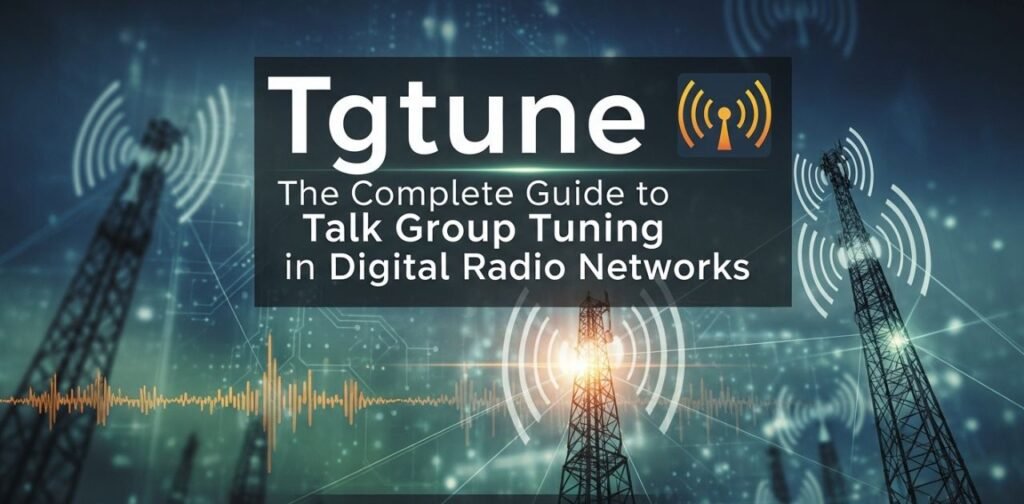Digital voice communications are becoming increasingly popular in the amateur radio community. With platforms like DMR, YSF, and AllStarLink, operators have access to thousands of talk groups and reflector networks. However, managing and switching between these groups can be a challenge. This is where Tgtune (Talk Group Tune) comes in—a feature or dialplan logic that allows radio users to dynamically switch talk groups without needing to manually disconnect and reconnect.
In this article, we’ll explore what Tgtune is, how it works, its benefits, configuration methods, common use cases, and future possibilities. By the end, you’ll understand why Tgtune is such an important tool for seamless amateur radio communication.
What Is Tgtune?
Tgtune, often written as “TG Tune,” is a dialplan context or system feature used in digital voice bridging systems such as DVSwitch and AllStarLink. It allows users to enter a command (often via DTMF tones) that instructs the system to switch to a new talk group dynamically.
For example:
- A user keys up and dials a specific DTMF code such as
*0911234. - The system interprets “1234” as the target talk group number.
- Tgtune then executes a script (such as
dvswitch.sh tune 1234) to connect the bridge to that talk group. - A voice announcement may confirm the change, letting the user know they are now active on TG 1234.
This eliminates the need to edit configuration files or restart nodes every time an operator wants to try a new talk group.
Why Is It Important?
Without Tgtune, users would be limited to a small set of pre-defined talk groups or would need complicated manual processes to change them. Tgtune makes it flexible, fast, and operator-friendly to:
- Explore different talk groups on demand.
- Reduce downtime when switching.
- Improve the usability of digital radio bridges.
In other words, Tgtune turns talk group management into something as simple as dialing a number.
How Tgtune Works in Practice
To better understand Tgtune, let’s look at its technical workflow and real-world usage.
Step 1: User Input
The operator sends a DTMF sequence or command from their radio. Typically, this begins with a star code like *091 followed by the desired talk group number.
Step 2: Dialplan Context
In the system’s Asterisk extensions.conf, a [tgtune] context is created. This context matches the DTMF digits dialed and routes them to the tuning script. For example:
[tgtune]
exten => _X.,1,System(/opt/dvswitch/dvswitch.sh tune ${EXTEN})
This simple line tells the system: “Whatever number the user dialed, send it to the dvswitch tuning script.”
Step 3: Script Execution
The script (dvswitch.sh in DVSwitch setups) handles the backend logic. It sends a command to the digital voice bridge, which connects the node to the specified talk group.
Step 4: Confirmation
Many Tgtune setups include an audio announcement feature. The system will play a voice message confirming the new talk group so the operator knows the switch was successful.
Benefits of Using Tgtune
Tgtune offers several practical advantages for amateur radio operators:
1. Flexibility
Instead of being locked to a handful of static talk groups, users can explore any talk group in real time. This makes digital networks far more dynamic and interactive.
2. Simplicity
Operators don’t need advanced technical knowledge. A simple DTMF sequence is enough to trigger a new connection.
3. Efficiency
Switching between talk groups takes seconds instead of minutes. This keeps the conversation flowing and reduces downtime.
4. Enhanced Interoperability
Tgtune works across different platforms such as DMR, YSF, P25, and NXDN, making it a powerful tool for multi-mode bridges.
5. Customization
Administrators can configure Tgtune to allow or restrict certain talk groups, providing control and security in shared repeater or hub environments.
Setting Up Tgtune: A Practical Guide
Configuring Tgtune typically involves editing your Asterisk configuration files and ensuring that your DVSwitch or AllStarLink system can interpret the commands.
1. Add a Tgtune Context
In your extensions.conf, add something like:
[tgtune]
exten => _X.,1,System(/opt/dvswitch/dvswitch.sh tune ${EXTEN})
This captures any numeric input and sends it to the script.
2. Update rpt.conf
In rpt.conf, you may need to set an autopatch or macro that points to the [tgtune] context. Example:
autopatchup= *091
context=tgtune
3. Test with DTMF
From your radio, transmit DTMF *0913100 (for example). If configured correctly, the system should announce: “Tuned to talk group 3100.”
4. Fine-Tune Permissions
You can restrict access to specific talk groups, set timeouts, or customize announcements depending on your network’s needs.
Common Challenges and Solutions
Like any system feature, Tgtune may present some challenges:
- DTMF Reliability: Some radios may not send clean DTMF tones. Solution: Adjust squelch or test different radios.
- Script Errors: If the tuning script fails, double-check file paths and permissions.
- Talk Group Availability: Not all talk groups are available on every network. Ensure you are targeting active ones.
- Security Concerns: In open systems, unrestricted Tgtune could be abused. Use access lists where possible.
With careful configuration, these issues can be minimized.
FAQs About Tgtune
1. What exactly does Tgtune stand for?
Tgtune is shorthand for Talk Group Tune, a feature used to dynamically switch between talk groups in digital radio networks.
2. Is Tgtune only for DVSwitch?
No. While it is commonly used in DVSwitch setups, Tgtune can be integrated into AllStarLink and other Asterisk-based bridging systems.
3. Do I need programming skills to set it up?
Not necessarily. Basic familiarity with Asterisk configuration files is enough. Most Tgtune setups only require a few lines of code.
4. Can I restrict which talk groups users can tune to?
Yes. Administrators can configure access control lists to limit talk group options.
5. Will Tgtune work over analog FM repeaters?
No. Tgtune is specifically designed for digital talk groups on networks like DMR, YSF, and P25.
6. Is there a risk of system overload if many users tune at once?
Yes, heavy traffic can stress the bridge. It’s important to set timeouts and usage limits to protect network stability.
7. Can I add voice announcements to confirm changes?
Absolutely. Many scripts include text-to-speech or pre-recorded audio prompts to confirm the selected talk group.
Conclusion: The Future of Tgtune in Amateur Radio
As amateur radio continues to embrace digital communication, features like Tgtune will become increasingly important. The ability to seamlessly switch talk groups without technical hurdles makes digital networks more accessible, engaging, and practical.
Looking ahead, we can expect:
- More automation, where Tgtune could be voice-activated instead of DTMF-based.
- Smarter bridges, capable of auto-routing users to active talk groups.
- Improved security features, ensuring that only authorized operators can access certain groups.
For operators who want flexibility, efficiency, and control, Tgtune is a must-have feature. It bridges the gap between traditional ham radio practices and the fast-moving world of digital voice networks.



